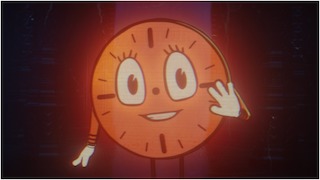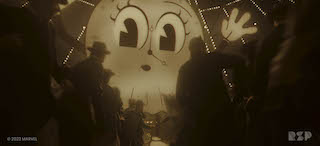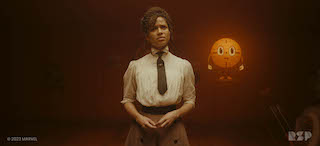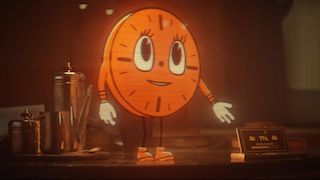 Rising Sun Pictures was a key visual effects provider for season two of Loki, the hugely popular series from Marvel and Disney+. The studio’s primary role was to animate Miss Minutes, an artificial intelligence driven character in the form of an orange clock who appears throughout the series, spreading propaganda on behalf of the Time Variance Authority, the organization that monitors timelines in the multiverse. RSP worked under the supervision of Marvel visual effects supervisors Christopher Townsend and Sandra Balej and visual effects producer Allison Paul.
Rising Sun Pictures was a key visual effects provider for season two of Loki, the hugely popular series from Marvel and Disney+. The studio’s primary role was to animate Miss Minutes, an artificial intelligence driven character in the form of an orange clock who appears throughout the series, spreading propaganda on behalf of the Time Variance Authority, the organization that monitors timelines in the multiverse. RSP worked under the supervision of Marvel visual effects supervisors Christopher Townsend and Sandra Balej and visual effects producer Allison Paul.
A fan favorite, Miss Minutes appeared in Loki’s debut season, but her role grows considerably in season two—and undergoes a sinister transformation. “She changes from a happy, charming AI assistant to one that is angry, power-hungry and, ultimately, deranged,” explains RSP visual effects supervisor Julian Hutchens. “She becomes more and more out of control.”
RSP was the sole vendor who worked on Miss Minutes and bringing her to life was challenging in several ways. She sometimes appears as an image on a screen, but more often pops up out of the blue as a freestanding hologram. Although superficially low tech, she is the product of sophisticated technology. A key aim for RSP’s animation team was to communicate the psychological depth and range of emotions experienced by Miss Minutes, whose design was inspired by vintage cartoons such as Felix the Cat. To accomplish that, artists drew inspiration from Tara Strong, the talented actress who voices the character.
A key aim for RSP’s animation team was to communicate the psychological depth and range of emotions experienced by Miss Minutes, whose design was inspired by vintage cartoons such as Felix the Cat. To accomplish that, artists drew inspiration from Tara Strong, the talented actress who voices the character.
“We were provided video reference of Tara delivering her lines, and used her expressions as a guide,” recalls Hutchens. “But that was just the starting point. We also had to consider where Miss Minutes was in the frame, what she was doing, who was she looking at, what was on her mind.”
Artists suggested Miss Minutes’ thought processes and mood swings through subtle changes in expression and movement—a curve of the lip or a flick of the wrist. “We tried to bring out the human element,” explains computer graphics supervisor Mathew Mackereth. “We’d ask ourselves, ‘what is she thinking?’ That became the bedrock of each shot and we built from there. A shrug of the shoulders or a shift in position can convey a lot. So, the naivety and simplicity of the character were actually plusses. We could lean into her facial features and create a character with range and nuance.”
 “You see it in the way the eyes work, the way they pop, the malleability of the mouth. Those details are relatively easy to draw, but hard to engineer. It was a grueling process, but our animators loved it. We’re a VFX studio, but on this project, we functioned more like an animation team.”
“You see it in the way the eyes work, the way they pop, the malleability of the mouth. Those details are relatively easy to draw, but hard to engineer. It was a grueling process, but our animators loved it. We’re a VFX studio, but on this project, we functioned more like an animation team.”
In one episode, Miss Minutes travels back in time to 1893 Chicago, when the city hosted the World Columbian Exposition and its display of what was then cutting-edge technology. In doing so, her appearance changes, taking on the look of the early animation of the period. “She flips a switch, spins around and becomes a black & white version of herself,” relates Hutchens. “Her face design changes. Her eyes become simpler, with triangle cutouts like Betty Boop. We also added jitter and other imperfections to give her image the endearing, throwback quality of early animation.”
 Incorporating Miss Minutes into background scenes required a delicate touch as compositors worked to preserve her unique features while making her feel part of the surrounding world. “Integrating her into the plates was always a challenge,” explains comp supervisor Liu Chorna. “In some scenes, we wanted to emphasize her physical presence by showing how she affects objects around her—a newspaper that swishes when she enters the room. On the other hand, we brought out her transparency with her light spilling into the background.”
Incorporating Miss Minutes into background scenes required a delicate touch as compositors worked to preserve her unique features while making her feel part of the surrounding world. “Integrating her into the plates was always a challenge,” explains comp supervisor Liu Chorna. “In some scenes, we wanted to emphasize her physical presence by showing how she affects objects around her—a newspaper that swishes when she enters the room. On the other hand, we brought out her transparency with her light spilling into the background.”
“We were going for the look of an old projector,” Chorna adds. “So, in every scene, we adjusted her lighting to reflect how she would look if projected into that real world environment. We also added high speed flickering as a projector would. All types of subtle work was needed to make her feel like she was a part of each scene.”
As the season progresses, Miss Minutes’ behavior becomes stranger and more erratic. In episode three she assumes a ghostly appearance and grows to immense size, frightening a crowd attending the exposition. In a later episode, she begins to seriously malfunction. “We wanted to show her passing through a series of states of stress,” recalls Hutchens. “We show her glitching more and more as her processing goes awry. Ultimately, we built a 3D rig and used it to create a skeleton of ASCII code, as if her whole body were made up of ones and zeros. The sequence builds until she fails completely.”
 Miss Minutes wasn’t RSP’s only contribution to season two. Effects artists added tesla sparks, smoke and other effects to the “time loom” Victor Timely (He Who Remains) displays at the exposition. They also created Loki’s signature green energy blasts used in several scenes. Most notably, the studio created a digital extension of an elaborate practical set representing a blighted, working-class section of Chicago. Drawing on a host of archival references, artists reproduced wood-frame tenements, trash strewn streets and other environmental features typical of the era.
Miss Minutes wasn’t RSP’s only contribution to season two. Effects artists added tesla sparks, smoke and other effects to the “time loom” Victor Timely (He Who Remains) displays at the exposition. They also created Loki’s signature green energy blasts used in several scenes. Most notably, the studio created a digital extension of an elaborate practical set representing a blighted, working-class section of Chicago. Drawing on a host of archival references, artists reproduced wood-frame tenements, trash strewn streets and other environmental features typical of the era.
Throughout the months-long project, RSP remained in constant contact with Marvel’s production team. “The direction we received from production was superb,” says Mackereth. “They were clear in what they wanted from Miss Minutes in terms of emotion and story points in every scene and shot. How we got her there was up to us. It was a great collaboration.”
RSP VFX producer Rachel Copp says the studio had a similarly fruitful relationship with other VFX vendors. “The communication was excellent,” she insists. “Visual effects has become a global industry and it’s very rewarding to interact with colleagues on the other side of the world in such a productive way. Everyone was mutually supportive and very good at getting assets to whomever needed them.”
Noting that RSP delivered more than 125 shots, Copp notes that the project went like clockwork. “It was wonderful,” she says. “Marvel’s team, Chris, Sandra and Allison, were super organized and had a clear vision. There were no delays. We finished on time, without going down to the wire, just as it was meant to. It’s been really good.”
Hutchens thinks that viewers of the show will be pleased by RSP’s contributions. “Fans are going to enjoy getting reacquainted with Miss Minutes,” he says. “We stuck to the design principles established in the first season but go deeper into her character with results that are surprising, visually compelling and fun. It’s been quite a creative journey.”
